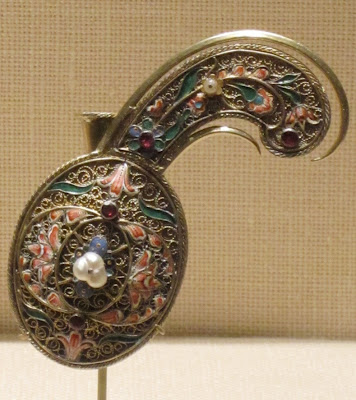 |
| AMERICAN FLORAL QUILT MOTIF WITH PAISLEY PETALS. |
|
|
 |
| CLOSE-UP OF BLUE PAISLEY WITH JAGGED EDGES. |
My first blog entry was the story of my mother's Aunt Flora
who came one summer for an extended visit. Readers may remember that it was
this woman who went shopping with me for a head scarf and selected a
paisley because "a paisley is
always good." She didn't,
however, have an answer for me when I
asked "What was a paisley?"
Aunt Flora had decided to make a floral patchwork quilt for
my bed during her stay and had evidently worked out the pattern of almost 150
flowers with unrepeated floral print petals well before making the trip. However, she waited until she got to Detroit
to buy the fabric, with the help of my mother.
Her selection of floral prints and their corresponding solid
color companions took place at a small, local fabric store, I really can't remember where. But I do remember that the job was done with
great efficiency and speed.
In recent years, I
have used the quilt as a bedcover, frequently studying the 1950's patterns -- never
even hoped to find a paisley. Then on a recent day, there it was, blue with a
jagged border and three little red dots as inside filling, rather conventional
little flowers as companions and all against a white ground. It seemed somewhat strange that there was
only one paisley print. Perhaps the
postwar paisley trend was just coming into its own and hadn't filtered down to
inexpensive cotton yard goods.
The discovery prompted the recollection of the importance of
American quilting as historical documentation -- of a family, an era, the
fabric industry. From what was been
observed, early American textiles were not the works of art that were produced
in Europe and Asia at that time. However, the craftswomenship of quilting and
embroidery of the 18th and 19th centuries is outstanding and historically
important. One can look back at the
milestone of the red-and-white quilt exhibit sponsored by the American
Folk Art Museum
in 2011, 650 quilts sensationally hung from the mile-high ceilings of the Park
Avenue Armory. There is also the crazy
quilt genre that seems to have created a 1880s American fad after people saw
the Japanese Exhibit in the 1876 Philadelphia Centennial Exposition. And also of importance is the story of the
"Underground Railroad Quilt Code" and the possibility that the
display of these quilts offered messages for escaped slaves.
So, thank you Aunt Flora for the little paisley message that
endures. JP



















